Advanced Database and Applications: Data Modeling and ER Approach
VerifiedAdded on 2023/06/07
|19
|4534
|368
Report
AI Summary
This report delves into the critical area of data storage and database design, focusing on data modeling and its relationship with the Entity Relationship (ER) approach. The introduction highlights the importance of databases in modern data management, defining databases and their components, such as tables, fields, and records. The report then explores data modeling using the ER approach, explaining the concept of data models, their components (data objects, associations, and rules), and their significance in database design. The core of the report discusses the ER model, detailing its constructs (entities, relationships, and attributes), and how it is applied in the database design process. The report also covers the relational model, including mapping entities, relationships, and weak entities, and mapping hierarchical entities. Finally, the report highlights the benefits of data models, providing a comprehensive overview of data modeling, ER models, relational models, and their applications in database systems.
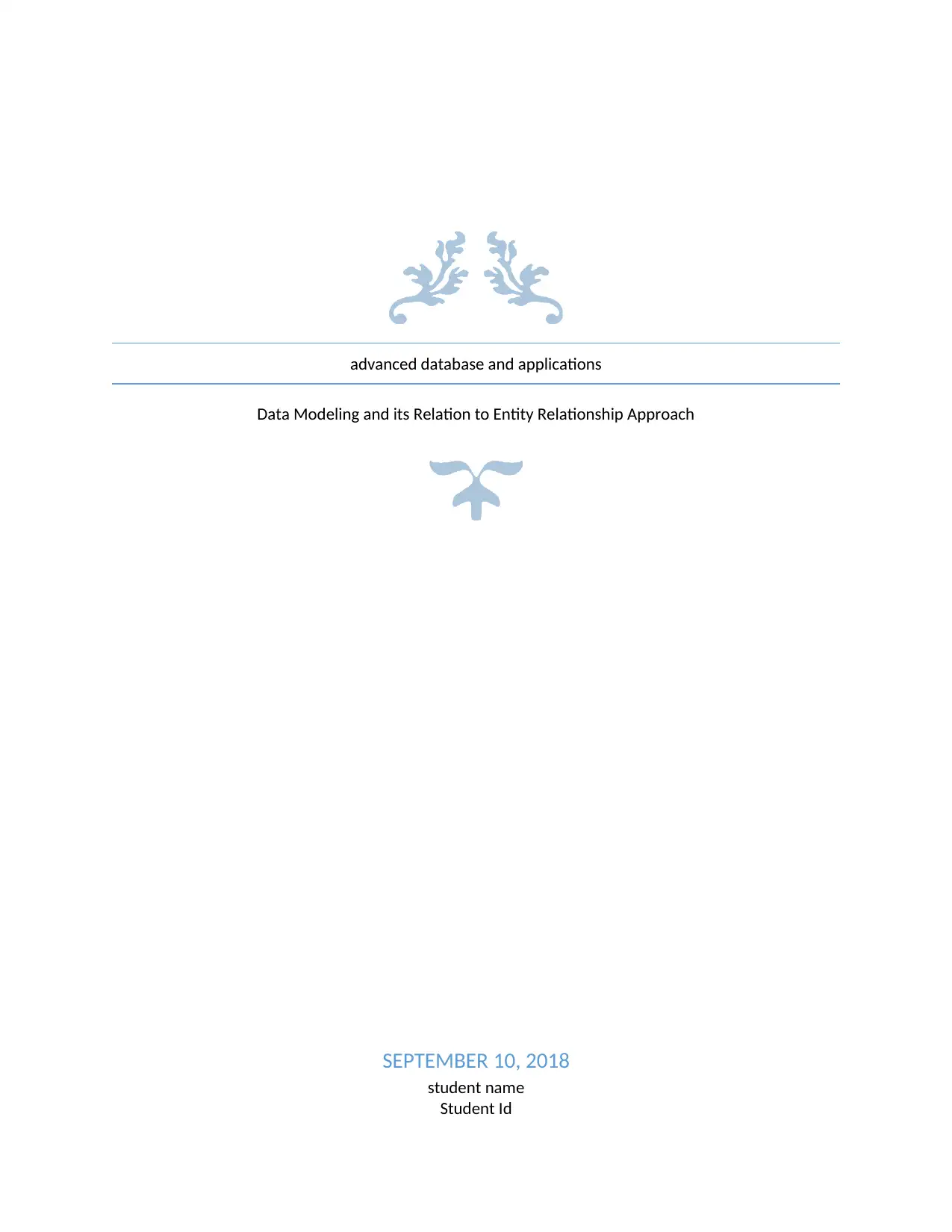
advanced database and applications
Data Modeling and its Relation to Entity Relationship Approach
SEPTEMBER 10, 2018
student name
Student Id
Data Modeling and its Relation to Entity Relationship Approach
SEPTEMBER 10, 2018
student name
Student Id
Paraphrase This Document
Need a fresh take? Get an instant paraphrase of this document with our AI Paraphraser
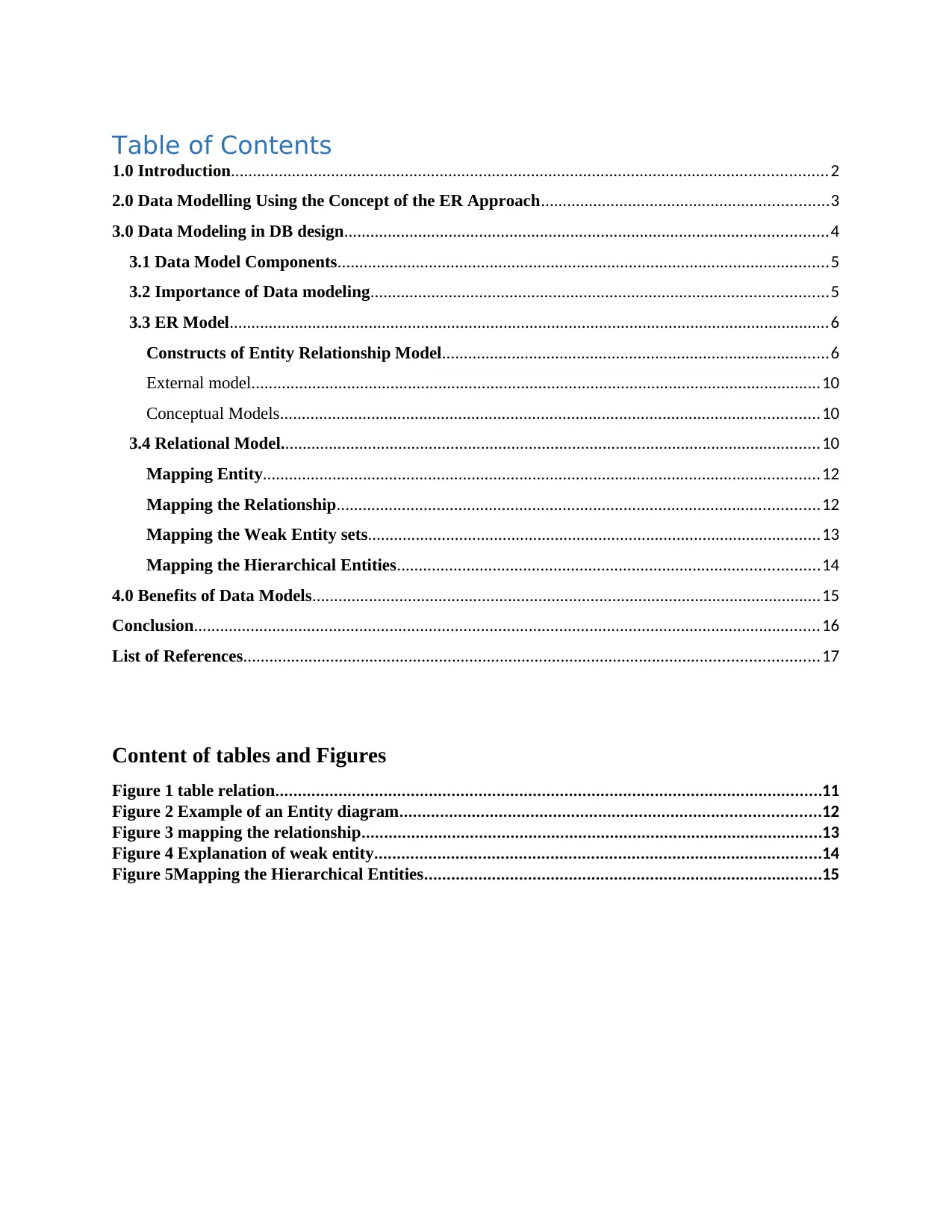
Table of Contents
1.0 Introduction.........................................................................................................................................2
2.0 Data Modelling Using the Concept of the ER Approach..................................................................3
3.0 Data Modeling in DB design...............................................................................................................4
3.1 Data Model Components.................................................................................................................5
3.2 Importance of Data modeling.........................................................................................................5
3.3 ER Model..........................................................................................................................................6
Constructs of Entity Relationship Model.........................................................................................6
External model...................................................................................................................................10
Conceptual Models............................................................................................................................10
3.4 Relational Model............................................................................................................................10
Mapping Entity................................................................................................................................12
Mapping the Relationship...............................................................................................................12
Mapping the Weak Entity sets........................................................................................................13
Mapping the Hierarchical Entities.................................................................................................14
4.0 Benefits of Data Models.....................................................................................................................15
Conclusion................................................................................................................................................16
List of References....................................................................................................................................17
Content of tables and Figures
Figure 1 table relation.........................................................................................................................11
Figure 2 Example of an Entity diagram.............................................................................................12
Figure 3 mapping the relationship......................................................................................................13
Figure 4 Explanation of weak entity...................................................................................................14
Figure 5Mapping the Hierarchical Entities........................................................................................15
1.0 Introduction.........................................................................................................................................2
2.0 Data Modelling Using the Concept of the ER Approach..................................................................3
3.0 Data Modeling in DB design...............................................................................................................4
3.1 Data Model Components.................................................................................................................5
3.2 Importance of Data modeling.........................................................................................................5
3.3 ER Model..........................................................................................................................................6
Constructs of Entity Relationship Model.........................................................................................6
External model...................................................................................................................................10
Conceptual Models............................................................................................................................10
3.4 Relational Model............................................................................................................................10
Mapping Entity................................................................................................................................12
Mapping the Relationship...............................................................................................................12
Mapping the Weak Entity sets........................................................................................................13
Mapping the Hierarchical Entities.................................................................................................14
4.0 Benefits of Data Models.....................................................................................................................15
Conclusion................................................................................................................................................16
List of References....................................................................................................................................17
Content of tables and Figures
Figure 1 table relation.........................................................................................................................11
Figure 2 Example of an Entity diagram.............................................................................................12
Figure 3 mapping the relationship......................................................................................................13
Figure 4 Explanation of weak entity...................................................................................................14
Figure 5Mapping the Hierarchical Entities........................................................................................15
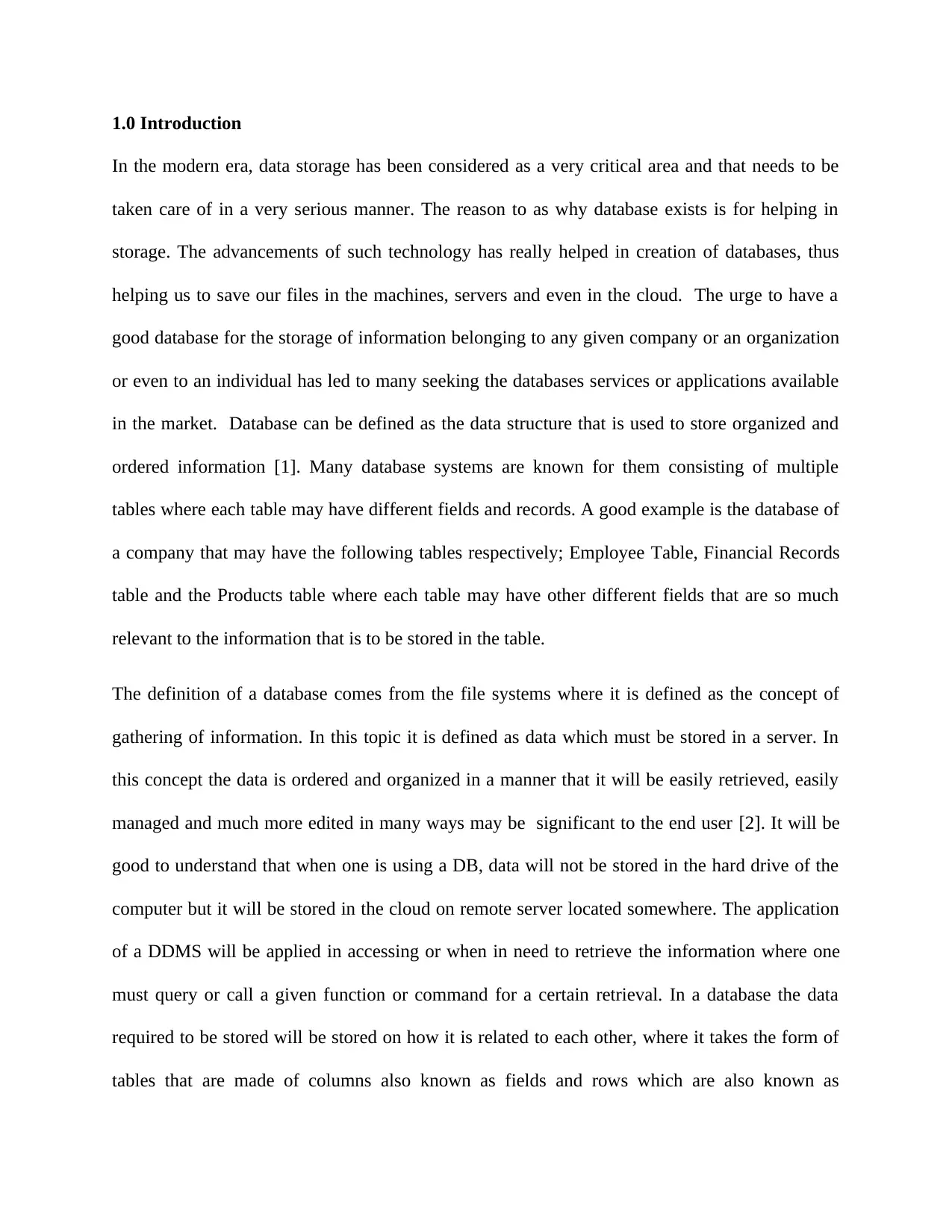
1.0 Introduction
In the modern era, data storage has been considered as a very critical area and that needs to be
taken care of in a very serious manner. The reason to as why database exists is for helping in
storage. The advancements of such technology has really helped in creation of databases, thus
helping us to save our files in the machines, servers and even in the cloud. The urge to have a
good database for the storage of information belonging to any given company or an organization
or even to an individual has led to many seeking the databases services or applications available
in the market. Database can be defined as the data structure that is used to store organized and
ordered information [1]. Many database systems are known for them consisting of multiple
tables where each table may have different fields and records. A good example is the database of
a company that may have the following tables respectively; Employee Table, Financial Records
table and the Products table where each table may have other different fields that are so much
relevant to the information that is to be stored in the table.
The definition of a database comes from the file systems where it is defined as the concept of
gathering of information. In this topic it is defined as data which must be stored in a server. In
this concept the data is ordered and organized in a manner that it will be easily retrieved, easily
managed and much more edited in many ways may be significant to the end user [2]. It will be
good to understand that when one is using a DB, data will not be stored in the hard drive of the
computer but it will be stored in the cloud on remote server located somewhere. The application
of a DDMS will be applied in accessing or when in need to retrieve the information where one
must query or call a given function or command for a certain retrieval. In a database the data
required to be stored will be stored on how it is related to each other, where it takes the form of
tables that are made of columns also known as fields and rows which are also known as
In the modern era, data storage has been considered as a very critical area and that needs to be
taken care of in a very serious manner. The reason to as why database exists is for helping in
storage. The advancements of such technology has really helped in creation of databases, thus
helping us to save our files in the machines, servers and even in the cloud. The urge to have a
good database for the storage of information belonging to any given company or an organization
or even to an individual has led to many seeking the databases services or applications available
in the market. Database can be defined as the data structure that is used to store organized and
ordered information [1]. Many database systems are known for them consisting of multiple
tables where each table may have different fields and records. A good example is the database of
a company that may have the following tables respectively; Employee Table, Financial Records
table and the Products table where each table may have other different fields that are so much
relevant to the information that is to be stored in the table.
The definition of a database comes from the file systems where it is defined as the concept of
gathering of information. In this topic it is defined as data which must be stored in a server. In
this concept the data is ordered and organized in a manner that it will be easily retrieved, easily
managed and much more edited in many ways may be significant to the end user [2]. It will be
good to understand that when one is using a DB, data will not be stored in the hard drive of the
computer but it will be stored in the cloud on remote server located somewhere. The application
of a DDMS will be applied in accessing or when in need to retrieve the information where one
must query or call a given function or command for a certain retrieval. In a database the data
required to be stored will be stored on how it is related to each other, where it takes the form of
tables that are made of columns also known as fields and rows which are also known as
⊘ This is a preview!⊘
Do you want full access?
Subscribe today to unlock all pages.

Trusted by 1+ million students worldwide
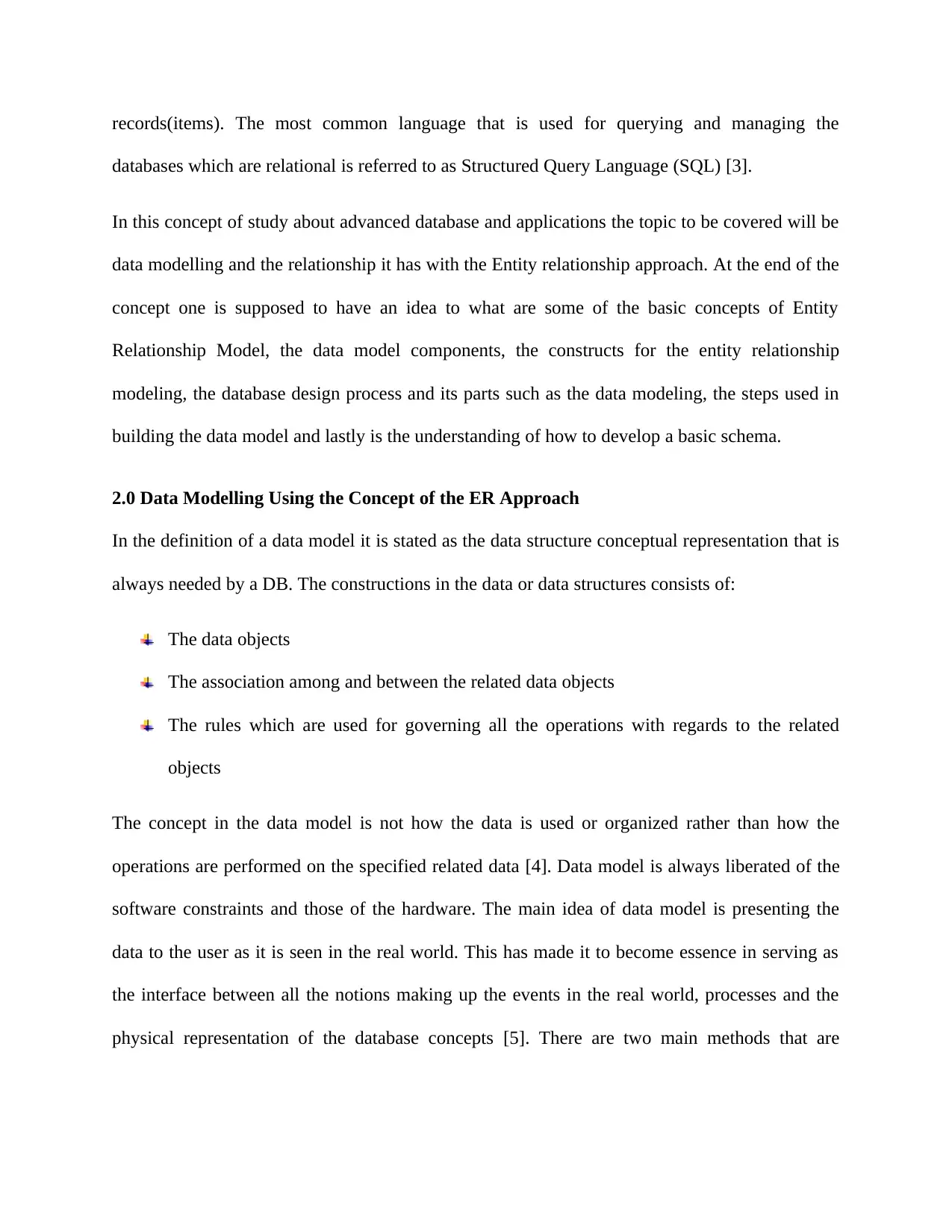
records(items). The most common language that is used for querying and managing the
databases which are relational is referred to as Structured Query Language (SQL) [3].
In this concept of study about advanced database and applications the topic to be covered will be
data modelling and the relationship it has with the Entity relationship approach. At the end of the
concept one is supposed to have an idea to what are some of the basic concepts of Entity
Relationship Model, the data model components, the constructs for the entity relationship
modeling, the database design process and its parts such as the data modeling, the steps used in
building the data model and lastly is the understanding of how to develop a basic schema.
2.0 Data Modelling Using the Concept of the ER Approach
In the definition of a data model it is stated as the data structure conceptual representation that is
always needed by a DB. The constructions in the data or data structures consists of:
The data objects
The association among and between the related data objects
The rules which are used for governing all the operations with regards to the related
objects
The concept in the data model is not how the data is used or organized rather than how the
operations are performed on the specified related data [4]. Data model is always liberated of the
software constraints and those of the hardware. The main idea of data model is presenting the
data to the user as it is seen in the real world. This has made it to become essence in serving as
the interface between all the notions making up the events in the real world, processes and the
physical representation of the database concepts [5]. There are two main methods that are
databases which are relational is referred to as Structured Query Language (SQL) [3].
In this concept of study about advanced database and applications the topic to be covered will be
data modelling and the relationship it has with the Entity relationship approach. At the end of the
concept one is supposed to have an idea to what are some of the basic concepts of Entity
Relationship Model, the data model components, the constructs for the entity relationship
modeling, the database design process and its parts such as the data modeling, the steps used in
building the data model and lastly is the understanding of how to develop a basic schema.
2.0 Data Modelling Using the Concept of the ER Approach
In the definition of a data model it is stated as the data structure conceptual representation that is
always needed by a DB. The constructions in the data or data structures consists of:
The data objects
The association among and between the related data objects
The rules which are used for governing all the operations with regards to the related
objects
The concept in the data model is not how the data is used or organized rather than how the
operations are performed on the specified related data [4]. Data model is always liberated of the
software constraints and those of the hardware. The main idea of data model is presenting the
data to the user as it is seen in the real world. This has made it to become essence in serving as
the interface between all the notions making up the events in the real world, processes and the
physical representation of the database concepts [5]. There are two main methods that are
Paraphrase This Document
Need a fresh take? Get an instant paraphrase of this document with our AI Paraphraser
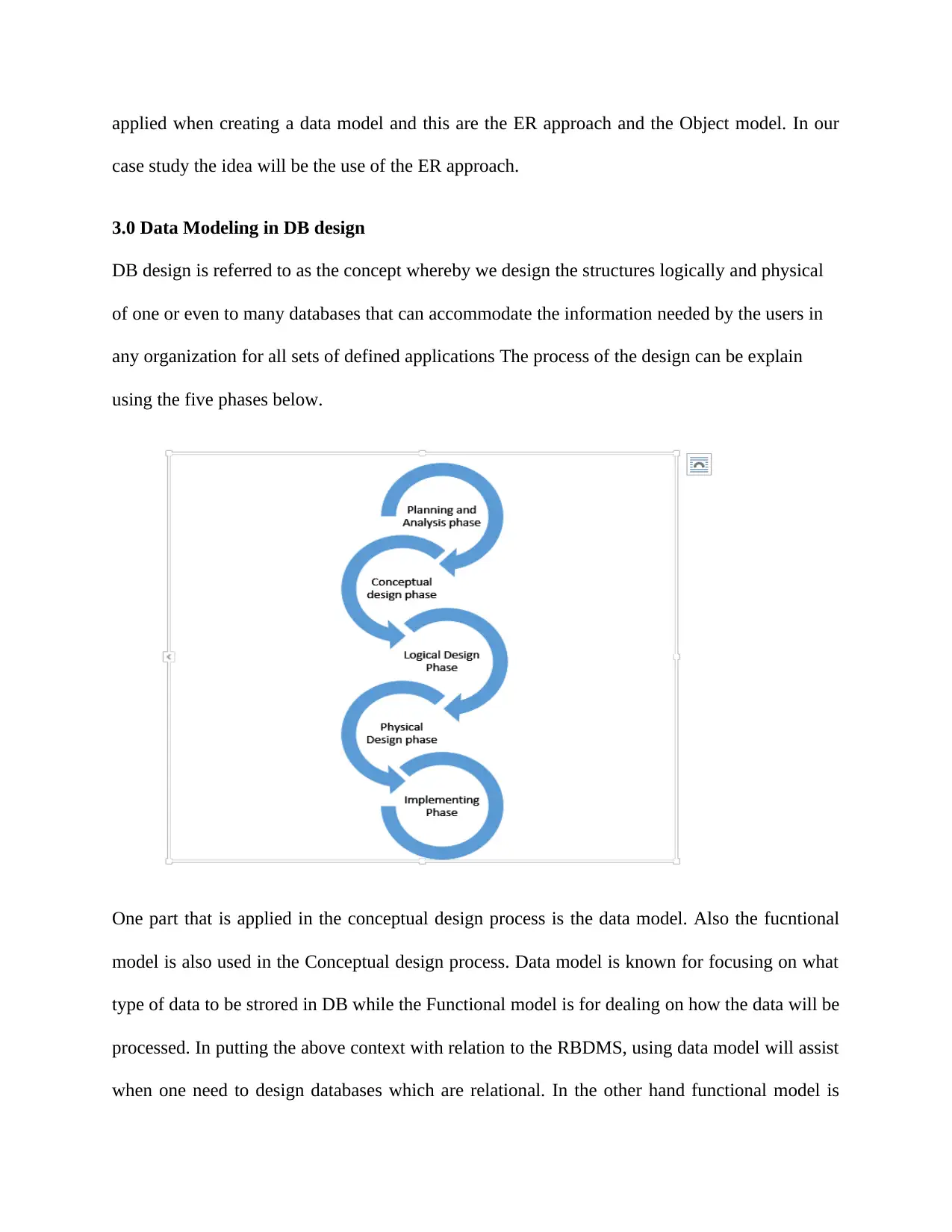
applied when creating a data model and this are the ER approach and the Object model. In our
case study the idea will be the use of the ER approach.
3.0 Data Modeling in DB design
DB design is referred to as the concept whereby we design the structures logically and physical
of one or even to many databases that can accommodate the information needed by the users in
any organization for all sets of defined applications The process of the design can be explain
using the five phases below.
One part that is applied in the conceptual design process is the data model. Also the fucntional
model is also used in the Conceptual design process. Data model is known for focusing on what
type of data to be strored in DB while the Functional model is for dealing on how the data will be
processed. In putting the above context with relation to the RBDMS, using data model will assist
when one need to design databases which are relational. In the other hand functional model is
case study the idea will be the use of the ER approach.
3.0 Data Modeling in DB design
DB design is referred to as the concept whereby we design the structures logically and physical
of one or even to many databases that can accommodate the information needed by the users in
any organization for all sets of defined applications The process of the design can be explain
using the five phases below.
One part that is applied in the conceptual design process is the data model. Also the fucntional
model is also used in the Conceptual design process. Data model is known for focusing on what
type of data to be strored in DB while the Functional model is for dealing on how the data will be
processed. In putting the above context with relation to the RBDMS, using data model will assist
when one need to design databases which are relational. In the other hand functional model is
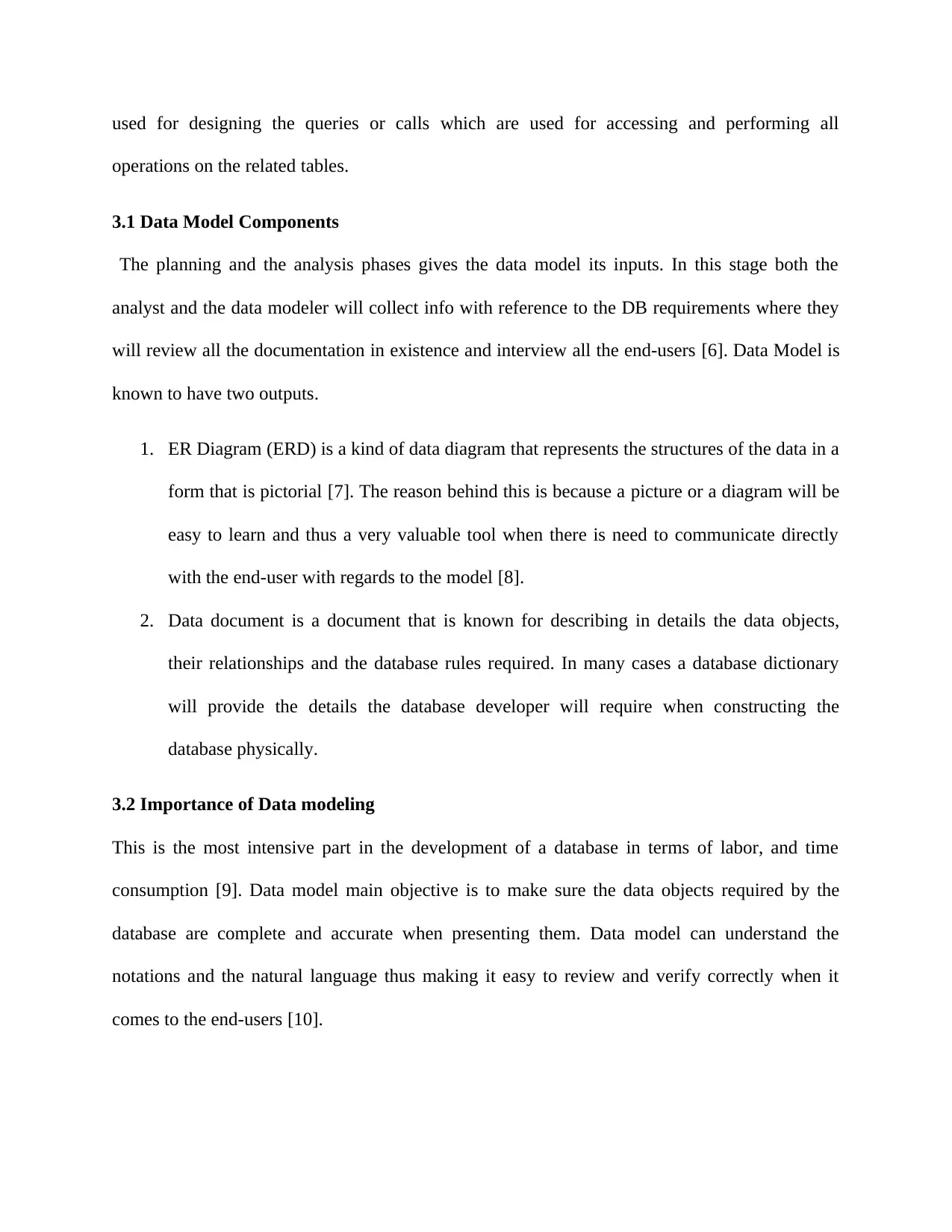
used for designing the queries or calls which are used for accessing and performing all
operations on the related tables.
3.1 Data Model Components
The planning and the analysis phases gives the data model its inputs. In this stage both the
analyst and the data modeler will collect info with reference to the DB requirements where they
will review all the documentation in existence and interview all the end-users [6]. Data Model is
known to have two outputs.
1. ER Diagram (ERD) is a kind of data diagram that represents the structures of the data in a
form that is pictorial [7]. The reason behind this is because a picture or a diagram will be
easy to learn and thus a very valuable tool when there is need to communicate directly
with the end-user with regards to the model [8].
2. Data document is a document that is known for describing in details the data objects,
their relationships and the database rules required. In many cases a database dictionary
will provide the details the database developer will require when constructing the
database physically.
3.2 Importance of Data modeling
This is the most intensive part in the development of a database in terms of labor, and time
consumption [9]. Data model main objective is to make sure the data objects required by the
database are complete and accurate when presenting them. Data model can understand the
notations and the natural language thus making it easy to review and verify correctly when it
comes to the end-users [10].
operations on the related tables.
3.1 Data Model Components
The planning and the analysis phases gives the data model its inputs. In this stage both the
analyst and the data modeler will collect info with reference to the DB requirements where they
will review all the documentation in existence and interview all the end-users [6]. Data Model is
known to have two outputs.
1. ER Diagram (ERD) is a kind of data diagram that represents the structures of the data in a
form that is pictorial [7]. The reason behind this is because a picture or a diagram will be
easy to learn and thus a very valuable tool when there is need to communicate directly
with the end-user with regards to the model [8].
2. Data document is a document that is known for describing in details the data objects,
their relationships and the database rules required. In many cases a database dictionary
will provide the details the database developer will require when constructing the
database physically.
3.2 Importance of Data modeling
This is the most intensive part in the development of a database in terms of labor, and time
consumption [9]. Data model main objective is to make sure the data objects required by the
database are complete and accurate when presenting them. Data model can understand the
notations and the natural language thus making it easy to review and verify correctly when it
comes to the end-users [10].
⊘ This is a preview!⊘
Do you want full access?
Subscribe today to unlock all pages.

Trusted by 1+ million students worldwide
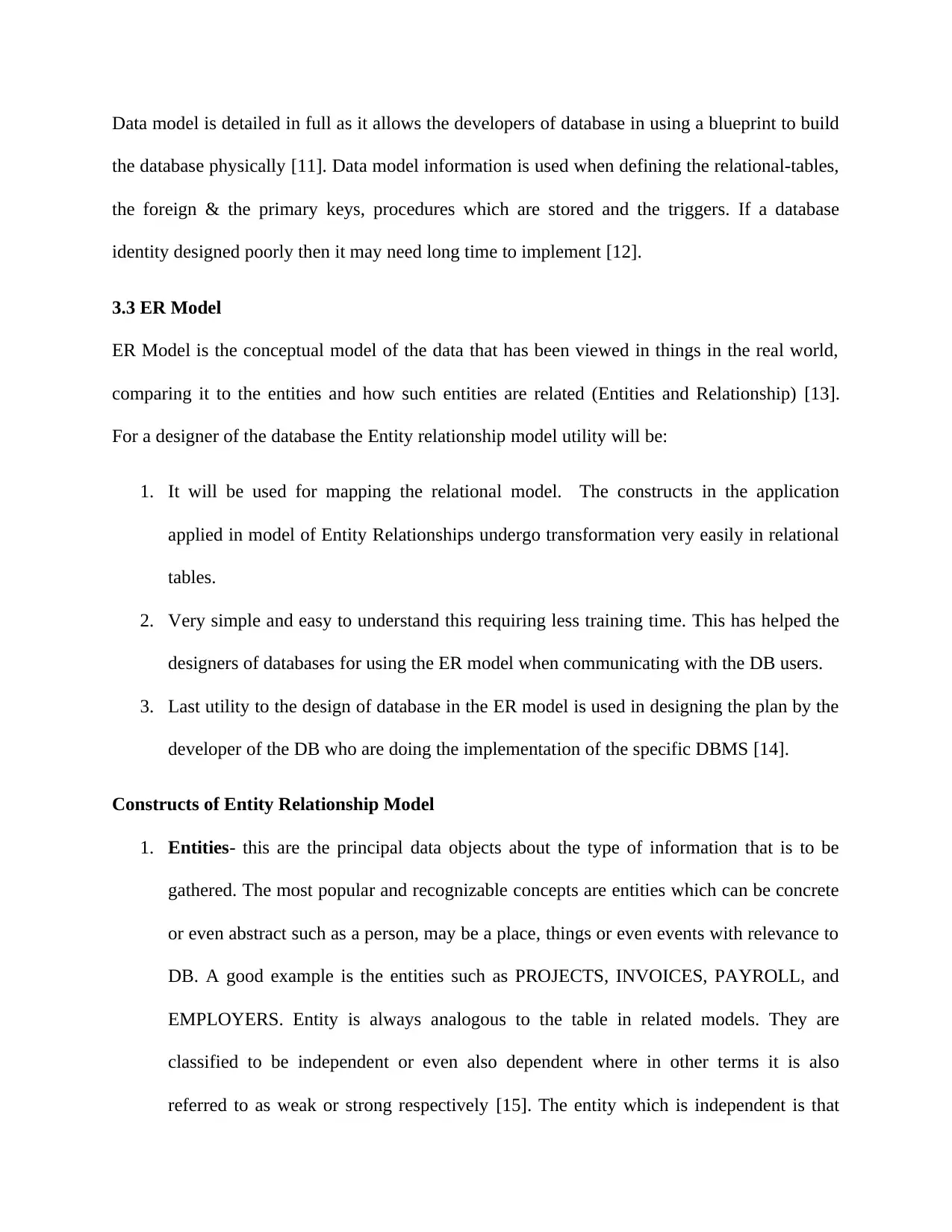
Data model is detailed in full as it allows the developers of database in using a blueprint to build
the database physically [11]. Data model information is used when defining the relational-tables,
the foreign & the primary keys, procedures which are stored and the triggers. If a database
identity designed poorly then it may need long time to implement [12].
3.3 ER Model
ER Model is the conceptual model of the data that has been viewed in things in the real world,
comparing it to the entities and how such entities are related (Entities and Relationship) [13].
For a designer of the database the Entity relationship model utility will be:
1. It will be used for mapping the relational model. The constructs in the application
applied in model of Entity Relationships undergo transformation very easily in relational
tables.
2. Very simple and easy to understand this requiring less training time. This has helped the
designers of databases for using the ER model when communicating with the DB users.
3. Last utility to the design of database in the ER model is used in designing the plan by the
developer of the DB who are doing the implementation of the specific DBMS [14].
Constructs of Entity Relationship Model
1. Entities- this are the principal data objects about the type of information that is to be
gathered. The most popular and recognizable concepts are entities which can be concrete
or even abstract such as a person, may be a place, things or even events with relevance to
DB. A good example is the entities such as PROJECTS, INVOICES, PAYROLL, and
EMPLOYERS. Entity is always analogous to the table in related models. They are
classified to be independent or even also dependent where in other terms it is also
referred to as weak or strong respectively [15]. The entity which is independent is that
the database physically [11]. Data model information is used when defining the relational-tables,
the foreign & the primary keys, procedures which are stored and the triggers. If a database
identity designed poorly then it may need long time to implement [12].
3.3 ER Model
ER Model is the conceptual model of the data that has been viewed in things in the real world,
comparing it to the entities and how such entities are related (Entities and Relationship) [13].
For a designer of the database the Entity relationship model utility will be:
1. It will be used for mapping the relational model. The constructs in the application
applied in model of Entity Relationships undergo transformation very easily in relational
tables.
2. Very simple and easy to understand this requiring less training time. This has helped the
designers of databases for using the ER model when communicating with the DB users.
3. Last utility to the design of database in the ER model is used in designing the plan by the
developer of the DB who are doing the implementation of the specific DBMS [14].
Constructs of Entity Relationship Model
1. Entities- this are the principal data objects about the type of information that is to be
gathered. The most popular and recognizable concepts are entities which can be concrete
or even abstract such as a person, may be a place, things or even events with relevance to
DB. A good example is the entities such as PROJECTS, INVOICES, PAYROLL, and
EMPLOYERS. Entity is always analogous to the table in related models. They are
classified to be independent or even also dependent where in other terms it is also
referred to as weak or strong respectively [15]. The entity which is independent is that
Paraphrase This Document
Need a fresh take? Get an instant paraphrase of this document with our AI Paraphraser

one which does not rely on any other entity for it to be identified while the entity which is
dependent the one that relies on another entity for it identification. There are special types
of entities namely.
Associative entity- this is an entity that is used for associating two or even more
entities for them to reconcile to relationship of many-to-many. It is also referred
to as the intersection entity.
Subtype Entity- this is an entity that is used in the generalization hierarchy for
representing the subset instances of the parent entity which is referred to as the
supertype and it has attributes or relationships that will only apply to the
specifics subsets.
2. Relationships- a relationship is any association between any two or more entities. A
good example of a relationship in this context will be as follows. Employees have been
assigned to perform some given tasks. The assigned projects have tasks and subtasks.
Each department can be able to manage one or even projects.
In DB a relationship can be categorized in terms of how they are connected to each other
(connectivity), degree, cardinality and the existence.
3. Attributes- this is a feature of database that gives description of the entity to which it is
associated with. A good example of illustrating what is an attribute is the value e.g.
“Marcus Garvey” is a good example of the attribute name. The attributes domain is
termed as the collection of all values possible that an attribute can have. Character string
is the name of the domain. They can be classified either as identifier or a descriptor.
Identifier attributes- they are normally called keys as they are known for uniquely
identifying any entity instance.
dependent the one that relies on another entity for it identification. There are special types
of entities namely.
Associative entity- this is an entity that is used for associating two or even more
entities for them to reconcile to relationship of many-to-many. It is also referred
to as the intersection entity.
Subtype Entity- this is an entity that is used in the generalization hierarchy for
representing the subset instances of the parent entity which is referred to as the
supertype and it has attributes or relationships that will only apply to the
specifics subsets.
2. Relationships- a relationship is any association between any two or more entities. A
good example of a relationship in this context will be as follows. Employees have been
assigned to perform some given tasks. The assigned projects have tasks and subtasks.
Each department can be able to manage one or even projects.
In DB a relationship can be categorized in terms of how they are connected to each other
(connectivity), degree, cardinality and the existence.
3. Attributes- this is a feature of database that gives description of the entity to which it is
associated with. A good example of illustrating what is an attribute is the value e.g.
“Marcus Garvey” is a good example of the attribute name. The attributes domain is
termed as the collection of all values possible that an attribute can have. Character string
is the name of the domain. They can be classified either as identifier or a descriptor.
Identifier attributes- they are normally called keys as they are known for uniquely
identifying any entity instance.
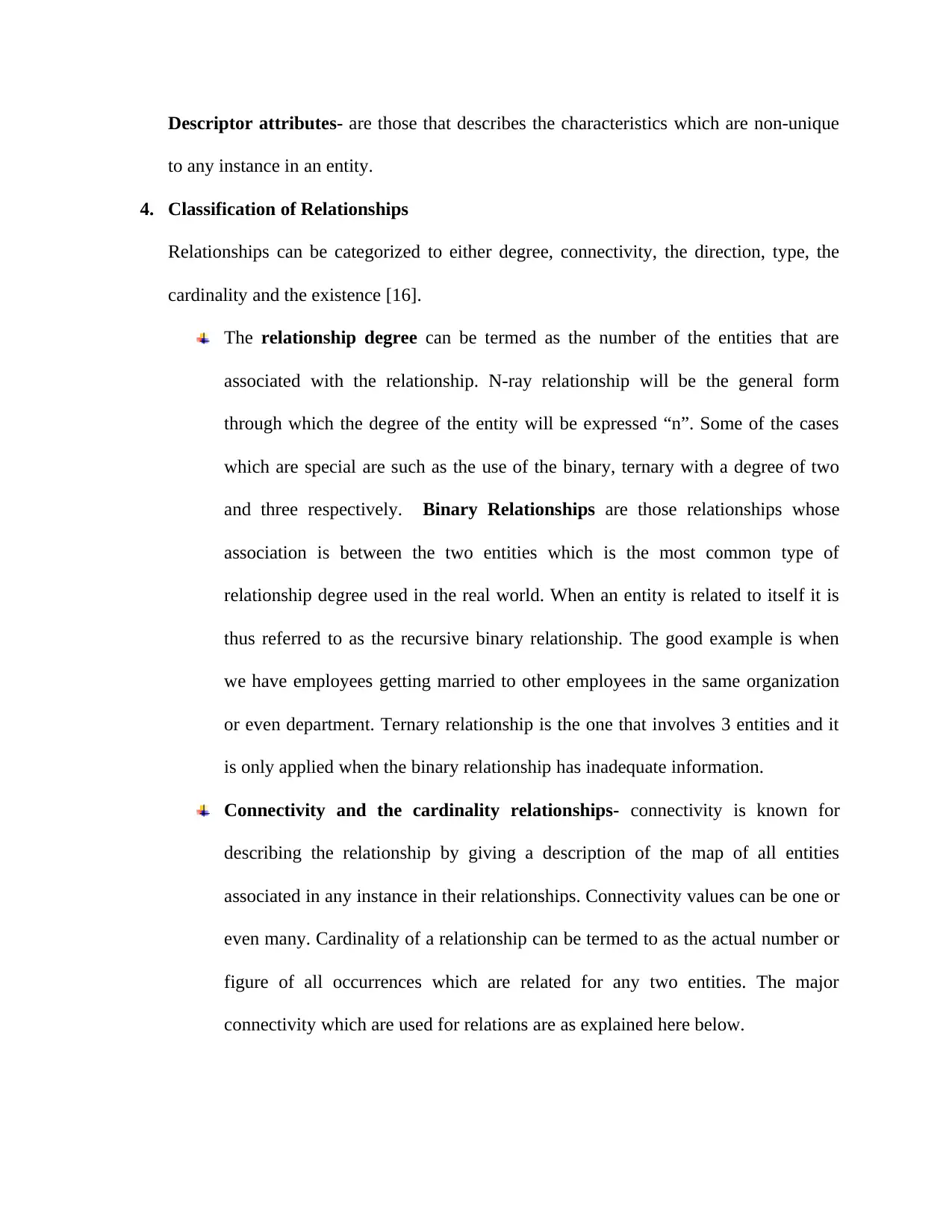
Descriptor attributes- are those that describes the characteristics which are non-unique
to any instance in an entity.
4. Classification of Relationships
Relationships can be categorized to either degree, connectivity, the direction, type, the
cardinality and the existence [16].
The relationship degree can be termed as the number of the entities that are
associated with the relationship. N-ray relationship will be the general form
through which the degree of the entity will be expressed “n”. Some of the cases
which are special are such as the use of the binary, ternary with a degree of two
and three respectively. Binary Relationships are those relationships whose
association is between the two entities which is the most common type of
relationship degree used in the real world. When an entity is related to itself it is
thus referred to as the recursive binary relationship. The good example is when
we have employees getting married to other employees in the same organization
or even department. Ternary relationship is the one that involves 3 entities and it
is only applied when the binary relationship has inadequate information.
Connectivity and the cardinality relationships- connectivity is known for
describing the relationship by giving a description of the map of all entities
associated in any instance in their relationships. Connectivity values can be one or
even many. Cardinality of a relationship can be termed to as the actual number or
figure of all occurrences which are related for any two entities. The major
connectivity which are used for relations are as explained here below.
to any instance in an entity.
4. Classification of Relationships
Relationships can be categorized to either degree, connectivity, the direction, type, the
cardinality and the existence [16].
The relationship degree can be termed as the number of the entities that are
associated with the relationship. N-ray relationship will be the general form
through which the degree of the entity will be expressed “n”. Some of the cases
which are special are such as the use of the binary, ternary with a degree of two
and three respectively. Binary Relationships are those relationships whose
association is between the two entities which is the most common type of
relationship degree used in the real world. When an entity is related to itself it is
thus referred to as the recursive binary relationship. The good example is when
we have employees getting married to other employees in the same organization
or even department. Ternary relationship is the one that involves 3 entities and it
is only applied when the binary relationship has inadequate information.
Connectivity and the cardinality relationships- connectivity is known for
describing the relationship by giving a description of the map of all entities
associated in any instance in their relationships. Connectivity values can be one or
even many. Cardinality of a relationship can be termed to as the actual number or
figure of all occurrences which are related for any two entities. The major
connectivity which are used for relations are as explained here below.
⊘ This is a preview!⊘
Do you want full access?
Subscribe today to unlock all pages.

Trusted by 1+ million students worldwide
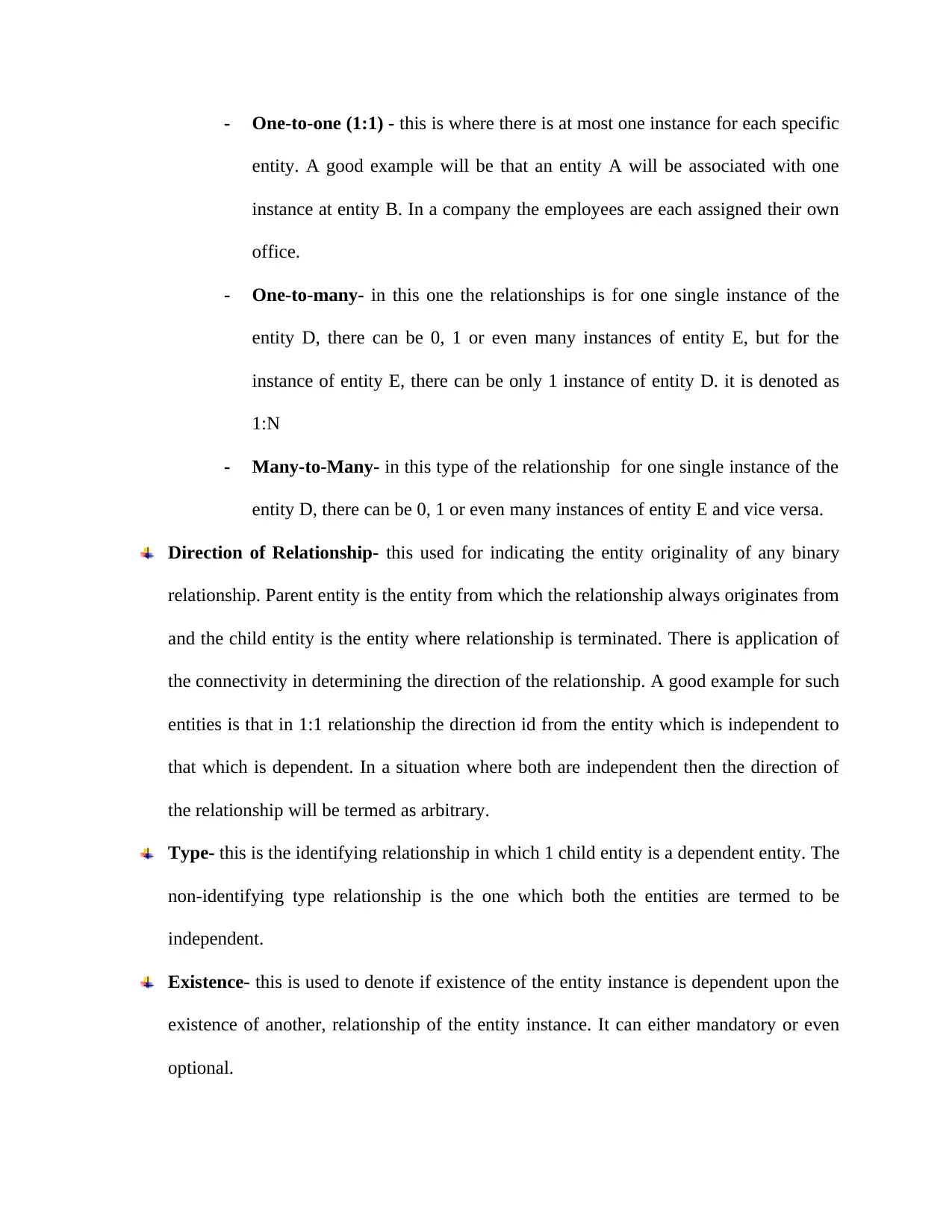
- One-to-one (1:1) - this is where there is at most one instance for each specific
entity. A good example will be that an entity A will be associated with one
instance at entity B. In a company the employees are each assigned their own
office.
- One-to-many- in this one the relationships is for one single instance of the
entity D, there can be 0, 1 or even many instances of entity E, but for the
instance of entity E, there can be only 1 instance of entity D. it is denoted as
1:N
- Many-to-Many- in this type of the relationship for one single instance of the
entity D, there can be 0, 1 or even many instances of entity E and vice versa.
Direction of Relationship- this used for indicating the entity originality of any binary
relationship. Parent entity is the entity from which the relationship always originates from
and the child entity is the entity where relationship is terminated. There is application of
the connectivity in determining the direction of the relationship. A good example for such
entities is that in 1:1 relationship the direction id from the entity which is independent to
that which is dependent. In a situation where both are independent then the direction of
the relationship will be termed as arbitrary.
Type- this is the identifying relationship in which 1 child entity is a dependent entity. The
non-identifying type relationship is the one which both the entities are termed to be
independent.
Existence- this is used to denote if existence of the entity instance is dependent upon the
existence of another, relationship of the entity instance. It can either mandatory or even
optional.
entity. A good example will be that an entity A will be associated with one
instance at entity B. In a company the employees are each assigned their own
office.
- One-to-many- in this one the relationships is for one single instance of the
entity D, there can be 0, 1 or even many instances of entity E, but for the
instance of entity E, there can be only 1 instance of entity D. it is denoted as
1:N
- Many-to-Many- in this type of the relationship for one single instance of the
entity D, there can be 0, 1 or even many instances of entity E and vice versa.
Direction of Relationship- this used for indicating the entity originality of any binary
relationship. Parent entity is the entity from which the relationship always originates from
and the child entity is the entity where relationship is terminated. There is application of
the connectivity in determining the direction of the relationship. A good example for such
entities is that in 1:1 relationship the direction id from the entity which is independent to
that which is dependent. In a situation where both are independent then the direction of
the relationship will be termed as arbitrary.
Type- this is the identifying relationship in which 1 child entity is a dependent entity. The
non-identifying type relationship is the one which both the entities are termed to be
independent.
Existence- this is used to denote if existence of the entity instance is dependent upon the
existence of another, relationship of the entity instance. It can either mandatory or even
optional.
Paraphrase This Document
Need a fresh take? Get an instant paraphrase of this document with our AI Paraphraser

Generalization Hierarchies- is a form kind of abstraction that is known for specifying
more entities sharing the attributes which are common and can be generalized in level
that is high with reference to the entity type and thus it is referred to as the generic entity
or supertype.
In designing the database it will be wise for the user in identifying the business rules, then
creating the database design and thus implementing the design using the available DBMS. For
decreasing of the level of abstraction the following order of models will need to be applied.
External model
- They are known for representing the views of the user in the database.
- Contain the multiple different views externally
- There are closely related with the real world as they are perceived by the user
Conceptual Models
- Providing flexibility for the data-structure capabilities
- Contain some data stored in the DB
- Shows the relationships in between or among the data, constraints, semantic
information and the security and the information integrity.
There are other models such as the internal and the physical model.
3.4 Relational Model.
Relational database management system is the most popular data model [17]. It is kind of model
that is more scientific than the others. The model is on the basis of the first order logic which are
predicate thus defining the table as the N-ray relation [18].
more entities sharing the attributes which are common and can be generalized in level
that is high with reference to the entity type and thus it is referred to as the generic entity
or supertype.
In designing the database it will be wise for the user in identifying the business rules, then
creating the database design and thus implementing the design using the available DBMS. For
decreasing of the level of abstraction the following order of models will need to be applied.
External model
- They are known for representing the views of the user in the database.
- Contain the multiple different views externally
- There are closely related with the real world as they are perceived by the user
Conceptual Models
- Providing flexibility for the data-structure capabilities
- Contain some data stored in the DB
- Shows the relationships in between or among the data, constraints, semantic
information and the security and the information integrity.
There are other models such as the internal and the physical model.
3.4 Relational Model.
Relational database management system is the most popular data model [17]. It is kind of model
that is more scientific than the others. The model is on the basis of the first order logic which are
predicate thus defining the table as the N-ray relation [18].
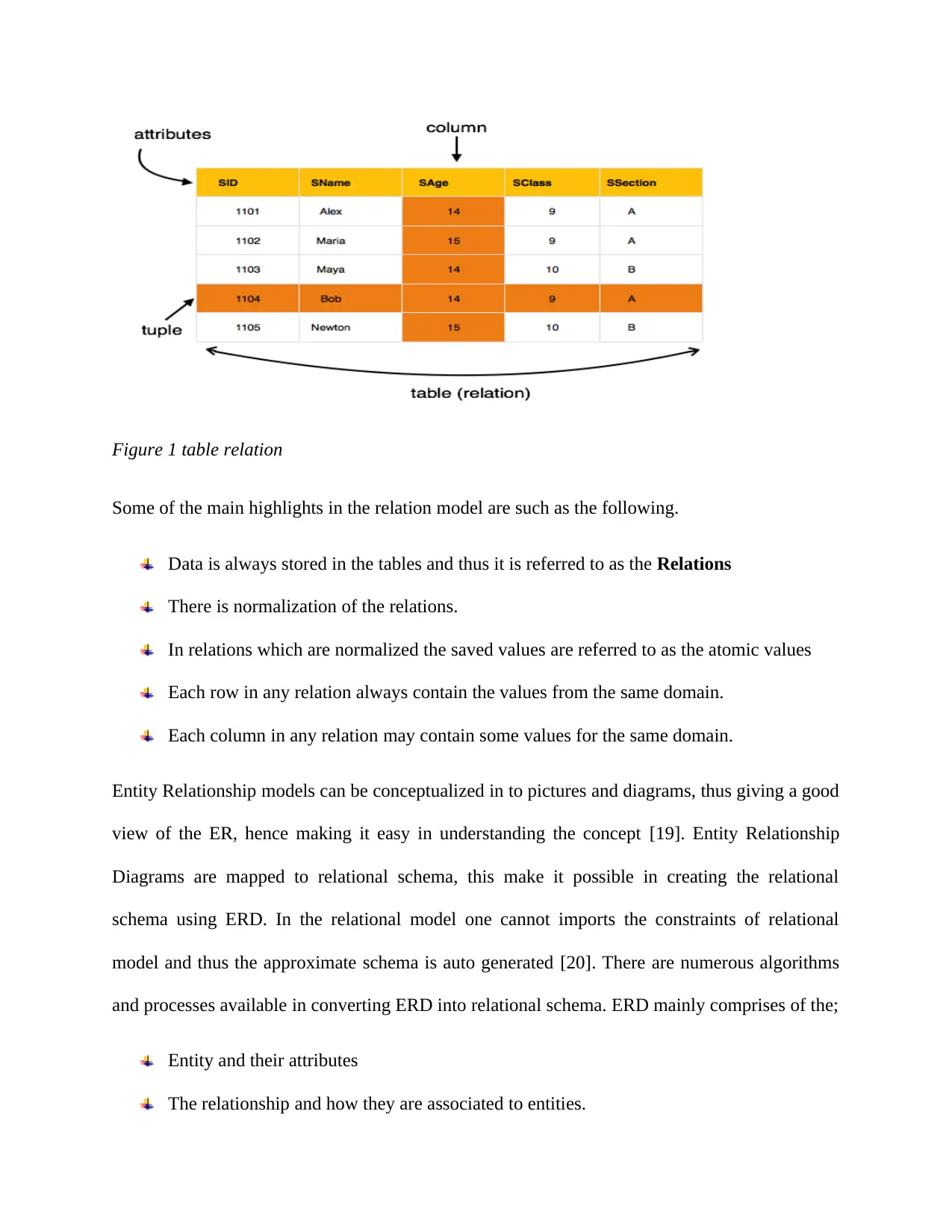
Figure 1 table relation
Some of the main highlights in the relation model are such as the following.
Data is always stored in the tables and thus it is referred to as the Relations
There is normalization of the relations.
In relations which are normalized the saved values are referred to as the atomic values
Each row in any relation always contain the values from the same domain.
Each column in any relation may contain some values for the same domain.
Entity Relationship models can be conceptualized in to pictures and diagrams, thus giving a good
view of the ER, hence making it easy in understanding the concept [19]. Entity Relationship
Diagrams are mapped to relational schema, this make it possible in creating the relational
schema using ERD. In the relational model one cannot imports the constraints of relational
model and thus the approximate schema is auto generated [20]. There are numerous algorithms
and processes available in converting ERD into relational schema. ERD mainly comprises of the;
Entity and their attributes
The relationship and how they are associated to entities.
Some of the main highlights in the relation model are such as the following.
Data is always stored in the tables and thus it is referred to as the Relations
There is normalization of the relations.
In relations which are normalized the saved values are referred to as the atomic values
Each row in any relation always contain the values from the same domain.
Each column in any relation may contain some values for the same domain.
Entity Relationship models can be conceptualized in to pictures and diagrams, thus giving a good
view of the ER, hence making it easy in understanding the concept [19]. Entity Relationship
Diagrams are mapped to relational schema, this make it possible in creating the relational
schema using ERD. In the relational model one cannot imports the constraints of relational
model and thus the approximate schema is auto generated [20]. There are numerous algorithms
and processes available in converting ERD into relational schema. ERD mainly comprises of the;
Entity and their attributes
The relationship and how they are associated to entities.
⊘ This is a preview!⊘
Do you want full access?
Subscribe today to unlock all pages.

Trusted by 1+ million students worldwide
1 out of 19
Related Documents
Your All-in-One AI-Powered Toolkit for Academic Success.
+13062052269
info@desklib.com
Available 24*7 on WhatsApp / Email
![[object Object]](/_next/static/media/star-bottom.7253800d.svg)
Unlock your academic potential
Copyright © 2020–2025 A2Z Services. All Rights Reserved. Developed and managed by ZUCOL.




